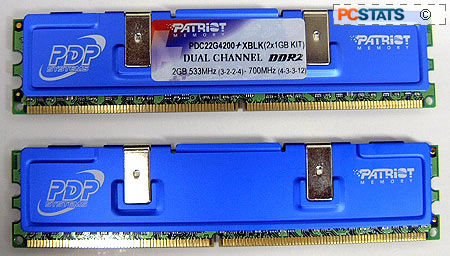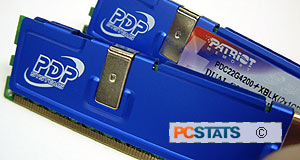PDP Systems Patriot PC2-4200 DDR2 XBL Memory Review
When it comes to
memory, there are two eternal truths; it can never be fast enough,
nor in a large enough quantity. For the longest time, 1GB of total system memory has been the sweet spot for PC
systems. Yet, with programs like Norton Systemworks 2005, Adobe Acrobat 6.0 and MS Office
2003 demanding more resources than ever, often 1GB of system RAM doesn't feel like enough
anymore!
Enthusiasts and
gamers often stick to systems with at least 2GB of system DDR RAM, and
aside from rewriting programs to use less memory or be more efficient, it's
the next logical step for the rest of us as well. So with that in mind, PCstats
will be examining a pair of 1GB DDR-2 modules from PDP Systems. Called the
Patriot DDR-2 eXtreme Bandwidth and Latency Kit. Each
of these 1GB PC2-4200 XBL sticks of memory have official timings of 3-2-2-4.
DDR-2 RAM is still slowly gaining momentum, but it's
only a matter of time before the entire computer industry (Intel and AMD)
moves over to the DDR-2 standard.
In any case, what we have on the test bench here
today is some rather nice DDR-2 RAM running at 533 MHz (PC4200), with timings of 3-2-2-4. When those timings are loosened up to 4-3-3-12,
PDP Systems PC2-4200 XBL RAM is almost able to 'fly' at 700 MHz, or PC2-5600 speeds! If you're wondering what "XBL" stands for
it, it's the acronym for "eXtreme Bandwidth and Latency," and looking at the specs for
these 1GB modules... it sure does look that way!
 |
|
PDP Systems Patriot PC-4200 DDR2 XBL |
|
|
 | |
By default the PDP Systems Patriot memory is rated to run at 533 MHz,
or PC4200 speeds with a voltage of 1.8V. These are the tightest timings we have seen
yet on DDR-2 DIMMs, and should give these sticks of Patriot memory that
little extra "umph" over the competition. Loosening the timings to 4-3-3-12, which
is still pretty aggressive, should mean that we'll be able to run them at about 700 MHz
with 1.9-2.0V!
Since DDR-2
memory is based on BGA DRAM, the DIMMs are protected with blue aluminum
Neng Tyi heatspreaders. During testing the memory really only became mildly
warm, and the heatspreaders are there more to prevent physical damage from occuring
than anything else.
PDP offers a
lifetime warranty with their memory, and that's reassuring since they've been in business for almost
20 years. One thing that I really liked was the toll free 1-800 number
that's listed on the packaging; nothing better than a number that I can call for
support!
PCStats Test Methodology and Overclocking
PCstats tests DDR-2 memory
on Intel Pentium 4 platform, since DDR-2 has not yet been introduced into the AMD world. While we
do test to see how high memory can go with aggressive 3-2-2-7 memory timings, and
the 3/4 memory divider enabled, we also loosen things up to see how high the
memory can go. The reason for this extra test is that Pentium 4 systems do not seem
as reliant on lower latency timings as AMD systems have in the past, and having a
higher clock speed can counteract the negative effect of higher timings.
Because much of our audience is made up
of enthusiasts, PCstats also runs overclocking tests so you can get an idea of
how far the memory will go.
Overclocking the
sucker!
 We've never dealt with
memory products from PDP Systems before, but considering
it states on the DIMMs that the PC2-4200 XBL memory is good up to 700
MHz, we had some pretty high hopes.
We've never dealt with
memory products from PDP Systems before, but considering
it states on the DIMMs that the PC2-4200 XBL memory is good up to 700
MHz, we had some pretty high hopes.
Keeping the 266 MHz (3/4 memory divider) enabled,
we slowly increased the FSB of the Gigabyte GA-8ANXP-D test system motherboard
while keeping the most aggressive memory timings possible. Without much fuss the
PC2-4200 XBL memory was able to crack the 600 MHz mark, but for us to hit 650
MHz we had to raise the DIMM voltage to 2.0V.
PDP
System's PC2-4200 XBL memory wouldn't go much higher than that, although with
aggressive timings we
were forced to loosen things up at 247 MHz FSB, or 659 MHz mark, which was the
memory's operating frequency. Unfortunately the Intel Pentium 4 540 CPU we use for testing
would not overclock high enough for the PDP Systems Patriot memory to fully hit 700
MHz. In the end we were only able to achieve a maximum overclock of 672 MHz, but I suspect
the system was holding the PDP Systems Patriot PC2-4200 XBL memory back.

